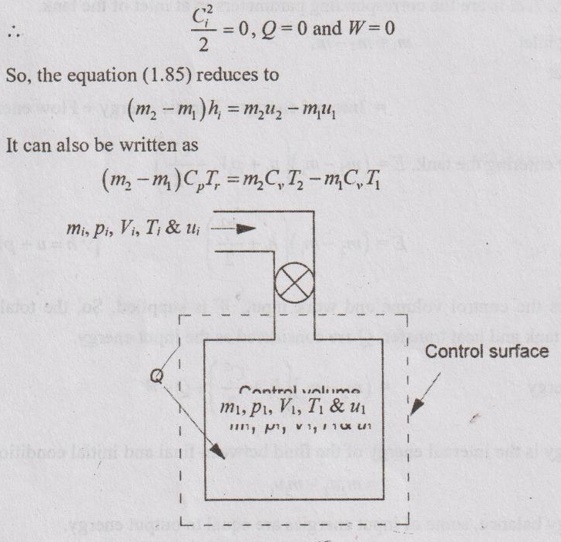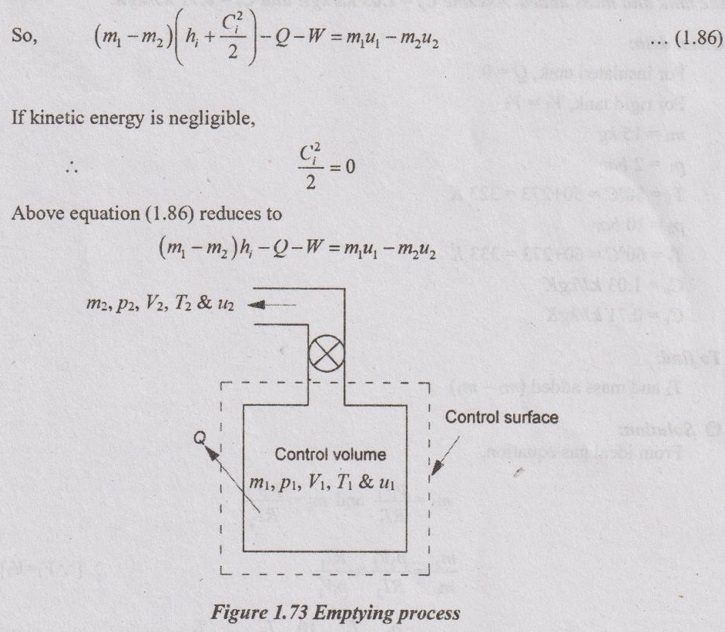In unsteady flow, the flow varies with respect to time.
UNSTEADY FLOW PROCESSES
In unsteady flow, the flow varies with respect to time. For example: Filling and emptying of vessels. It is mainly considered during startup and shutdown periods of machines.
The following assumptions are made for deriving the unsteady flow energy equation.
1. The rate of accumulation of energy within the control volume is equal to the net rate of energy flow across the Control Surface (CS).
2. The state of mass entering or leaving the control volume is constant with time.
Let,
m1 = Initial mass of fluid, kg/s
p1 = Initial pressure of fluid, Pa
V1 = Initial volume of fluid, m3
T1 = Initial temperature of fluid, K
u1 = Initial internal energy of fluid, W
Similarly, m2, p2, V2, T2 & u2 are the corresponding parameters in at final condition. Also let,
mi, pi, Vi, Ti & ui are the corresponding parameters in at inlet of the tank.
⸫ Mass at inlet mi = m2 – m1
We know that
Total energy
Internal energy + Kinetic energy + Flow energy

Q enters the control volume and work input, W is supplied. So, the total energy entering the tank and heat transfer, Q are considered as the input energy.
So, input energy 
Output energy is the internal energy of the fluid between final and initial conditions.
= m2u2 - m2u1
As per energy balance, some of input energies are equal to output energy.

1. Filling Process
Let us consider the bottle/ tank is to be filled from a large reservoir of temperature Tr as shown in Figure 1.72.
If kinetic energy is negligible,

Above equation (1.85) reduces to
(m2 - m1)hi + Q - W = m2u2 – m1u1
Q - W = m2u2 - m1u1 - (m2 – m1)h1
where hi ⇒ Flow energy or enthalpy of reservoir
Also, hi = CpTi
where Ti = Tr = Reservoir temperature
If kinetic energy is negligible, the tank is rigid and perfectly insulated,

2. Emptying process
In this process, the fluid flows from tank to the surrounding as shown in Figure 1.73. Emptying is a reverse process of filling. Therefore, the unsteady flow equation reduces similar to filling process.
Mass at inlet, mi = m1 - m2
In emptying process, Q leaves the control volume and work input, W is supplied. So, the total energy entering the tank and heat transfer, Q are considered as the input energy.
So, input energy 
As per energy balance, some of input energies are equal to output energy which internal energy of the fluid between final and initial conditions.

If kinetic energy is negligible, the tank is rigid and perfectly insulated,
⸫ Ci2 / 2 = 0, Q = 0 and W = 0
So, above equation (1.86) reduces to
(m1 - m2)h1 = m1u1 – m2u2
It can also be written as
(m1 - m2) CpTp = m1CvTr - m2CvT2
No comments:
Post a Comment